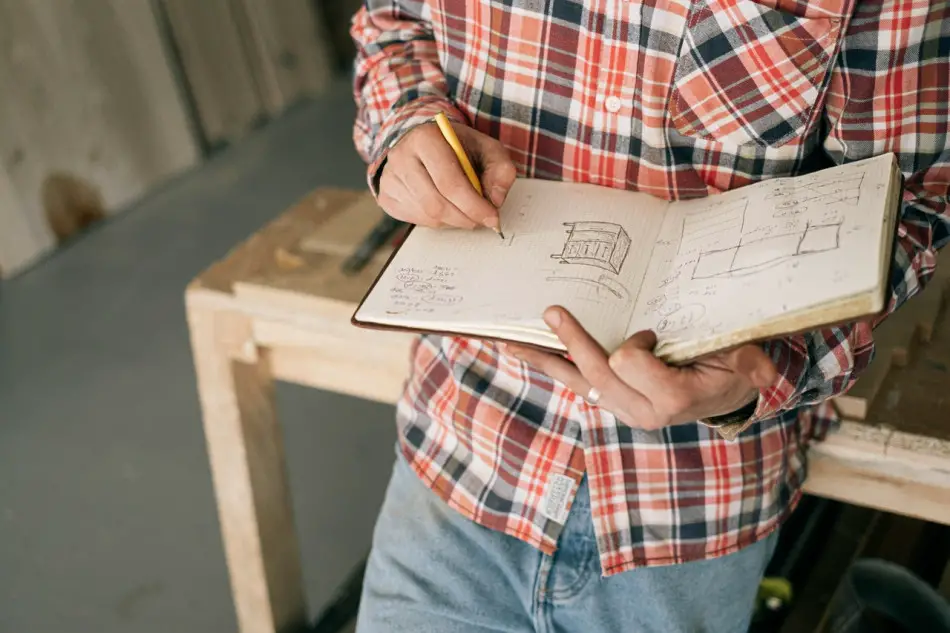Perhaps one of the oldest professions in the world, carpentry is an important trade that has been around for centuries.
Whether it’s building houses or creating furniture, carpentry is a versatile trade that can be used in a variety of ways.
But is it possible to learn carpentry all by yourself?
Yes, it’s definitely possible to learn carpentry by yourself! All you need to do is follow these four steps – strengthen your foundational knowledge, take an online carpentry course, find a seasoned carpenter to apprentice for, and lastly, join a construction crew.
While it’s easier said than done, if you put in the hard work and dedication, you can most certainly self-teach carpentry!
In this guide, we’ll take you through the nitty-gritty details of each of these steps so that by the end, you’ll be a bona fide carpenter.
Let’s get started!
4 Steps to Teach Yourself Carpentry
We know you’re excited to get started on your carpentry journey, so without further ado, here are the four steps you need to follow to teach yourself carpentry.
-> Read Also What Is An Autodidact?
Step One: Strengthen Your Foundational Knowledge

Before we dive into the more technical aspects of carpentry, it’s important to first strengthen your understanding of the basics.
This means brushing up on your knowledge in a few key areas.
1) Math
A huge chunk of carpentry revolves around math. You’ll be constantly measuring, calculating, and working with numbers on a daily basis.
If your math skills are a little rusty, now’s the time to brush up!
Here are the math concepts you’ll need on your journey to learning carpentry:
- Arithmetic: This includes concepts such as addition, subtraction, multiplication, and division. You’ll need to be able to quickly calculate measurements in your head without the aid of a calculator.
- Algebra: You’ll be dealing with a lot of variables as a carpenter. Algebra will come in handy when trying to solve for unknowns, such as the length of a piece of lumber you need to cut.
- Geometry: A lot of carpentry is based on geometry, especially when it comes to cutting angles and shaping wood. You’ll need to be comfortable with concepts such as lines, angles, and shapes.
- Calculus: This is one of the more advanced math concepts that you’ll need for carpentry. Calculus will come in handy when dealing with more complex equations, such as those involving volume or stress.
- Statistics: You’ll also need to be familiar with basic statistical concepts, such as mean, median, and mode. This will come in handy when trying to calculate things like the average cost of materials for a project.
All of these math concepts are important for carpentry, so make sure you brush up on them before moving on to the next step!
Check out this wonderful book as a starting point – Math for Carpentry and Construction by Richard. B. Miles.
2) Woodworking
Of course, you can’t be a carpenter without knowing about woodworking!
This is the bread and butter of carpentry, so it’s important to have a strong understanding of the different types of wood, how to work with them, and the various tools involved.
Take a look at some of the basics of woodworking you’ll need to know:
- The different types of wood and their properties.
- How to work with wood (cutting, measuring, sanding, etc).
- How to read blueprints and other technical drawings.
Most of these things need to be learned through experience, so make sure to get some hands-on experience with woodworking before moving on.
Watch a couple of YouTube videos (from channels such as Woodworking For Mere Mortals and John Heisz), and then try to build something small on your own.
Just get your hands dirty and have some fun with it!
3) Carpentry Tools
As a carpenter, you’ll be using a wide variety of tools on a daily basis. It’s important to have a strong understanding of how to use each tool properly and safely.
Start by familiarizing yourself with the most common carpentry tools, such as hammers, saws, screws, and nails. Then, try to get some experience using each tool.
From there, you can familiarize yourself with more specialized tools, such as power tools, hand tools, and measuring devices.
Again, most of this is best learned through experience. So get your hands on some tools and start tinkering!
If you want to learn more about carpentry tools, check out this great book – Tools of the Trade: Art and Craft of Carpentry by Jeff Taylor.
Step Two: Take an Online Carpentry Course
Now that you’ve brushed up on the basics, it’s time to start learning carpentry in earnest. The best way to do this is by taking an online course.
There are tons of great online carpentry courses designed for beginners, and you can find both free and paid ones on popular sites like Coursera and Udemy.
When choosing an online course, make sure to pick one that is comprehensive and covers all the basics of carpentry.
It should also come with plenty of video tutorials and other resources, so you can reference it later as needed.
Here are our recommendations:
- Udemy: Basic Carpentry – A well-rounded course that covers all the basics of carpentry, from woodworking to using various types of tools.
- Carpentry: Introduction to Construction Methods by Alison – A great free course that covers all the basics of carpentry, from an introduction to construction methods to using hand and power tools.
- Skillshare – This particular website has courses on almost any skill or trade you can think of, and carpentry is no exception. They have a few great courses on carpentry/woodworking, such as Introduction to Woodworking: The Basics and Make Your Own Furniture.
Once you’ve chosen a course (or two), it’s time to get started!
Dedicate some time each day or week and watch the lectures, do the exercises, and complete the projects.
By the end of the course (or courses), you should have a strong understanding of all the basics of carpentry.
You’ll also be able to build some simple projects on your own.
Step Three: Find A Seasoned Carpenter to Apprentice For

When you’re in the learning stage of carpentry, there’s no substitute for working with a seasoned professional.
The best way to do this is by finding a carpenter to apprentice for. This will give you the opportunity to learn from someone with years of experience in the trade.
You can find carpenters to apprentice for by searching online, or asking around at your local hardware store.
Once you find someone, reach out and see if they’re willing to take you on as an apprentice.
Most carpenters are happy to have someone to help out, and you’ll be able to learn a lot by working with them.
Just make sure to be respectful and follow their instructions carefully.
Note: Don’t expect to get paid for your work as an apprentice. This is a learning experience, not a job. If you do get paid, well and good. But try not to expect it.
Step Four: Join A Construction Crew
Once you have some experience under your belt, the next step is to join a construction crew.
Why a construction crew? Because a carpenter’s job is not just about building doors and crafting tables.
It’s also about working with a team of other tradespeople to complete a construction project.
Joining a construction crew is a great way to learn how to work with other people in the trade, and it will give you a chance to put your skills to the test.
You can find construction crews to join by reaching out to labor agencies or searching online. Once you find a crew that you’re interested in working with, reach out and see if they have any open positions.
Most construction crews are always looking for new members, so you shouldn’t have any trouble finding a spot on one.
But keep in mind that you might have to bring your own safety gear and basic tools (hammer, screwdriver, etc.) when you join one.
By now, you’ll have learned all the basics of carpentry and be able to work on construction projects with ease.
A couple of projects under your belt and you’ll be considered a seasoned professional in no time!
-> Learn More about Self-Learning vs. Classroom Learning: Which Is Better?
Different Types of Carpentry Work for Beginners

A lot of people think that carpentry is all about making things out of wood. But there’s a lot more to it than that.
Carpentry actually covers a wide range of different trades, from framing and trim work to cabinetry and furniture making.
If you want to learn carpentry, you can choose to focus on one particular trade or try your hand at all of them.
Here are some of the most popular types of carpentry work:
| Type of Carpentry | Description | Average Pay (dollar/hour) |
| Cabinet Carpentry | This type of carpentry is all about making cabinets and other storage solutions out of wood. | $21.36 |
| Finish Carpentry | Finish carpentry is all about the finer details of a construction project. This includes things like installing trim, molding, and baseboards. | $25.78 |
| Green Carpentry | Green carpentry is all about sustainable construction practices. This includes using recycled materials and building energy-efficient homes. | $19.09 |
| Industrial Carpentry | Highly skilled carpenters who work in factories and other industrial settings are known as industrial carpenters. They often work with heavy machinery and materials. | $21 |
| Joisters | Joists are horizontal beams that support a structure’s weight. Carpenters who specialize in this area of work are known as joisters. | $19.20 |
| Rough Carpentry | Rough carpenters are responsible for the framing of a structure. This includes putting up walls, ceilings, and roofs. It’s the polar opposite of what a finished carpenter does. | $19.10 |
| Roofer | As the name suggests, roofers are carpenters who specialize in installing and repairing roofs. | $18.06 |
| Scenic Carpentry | Scenic carpenters are responsible for building sets and props for movies, TV shows, and theater productions. | $19 |
| Ship Carpentry | Ship carpenters are responsible for building and repairing boats and other vessels. | $22 |
Few Tips to Make Learning Carpentry by Yourself Easier
Now that we’ve shown you the roadmap for learning carpentry, it’s time to share a few tips that will make the journey a little easier.
Here are a few things to keep in mind:
- Invest in a high-quality toolset: Tools are a carpenter’s best friend. But not just any tools will do. You need to make sure that you invest in a high-quality toolset that will last you for years to come.
- Get a strong, solid workbench: A workbench is one of the most important pieces of equipment for a carpenter. It’s where you’ll do all your work, so it needs to be strong and sturdy to withstand all the wear and tear.
- Create a safe working environment: Carpentry can be dangerous if you’re not careful. That’s why it’s important to create a safe working environment for yourself. This includes things like wearing the proper safety gear and keeping your workspace clean and organized.
- Skip the pens, use a carpenter’s pencil: This is something every carpenter learns with time. Pens can be hard to use when you’re working with wood. That’s why it’s better to use a carpenter’s pencil. They’re designed specifically for marking wood, so they’ll make your life a lot easier.
- Always recheck your measurements: This is a rule that all carpenters live by. A single millimeter can make a big difference when you’re working with wood. That’s why it’s always important to recheck your measurements before you start cutting.
-> Learn more about the 7 best websites for self-learning
Frequently Asked Questions (FAQs)

Here are some of the most commonly asked questions about carpentry:
Q.1. What is the difference between carpentry and woodworking?
A. The main difference between carpentry and woodworking is that carpentry is more focused on construction while woodworking is more focused on the creation of objects.
Along with wood, carpentry also uses other materials like metal, glass, and plastic.
Q.2. How long does it take to get a carpenter’s degree?
A. Most carpenter programs take between three and four years to complete, along with a few more years of apprenticeships.
Q.3. Do you need a license to practice carpentry?
A. While you don’t need a license to practice carpentry, most states do require that you have a license to work as a contractor.
Since each state has its own requirements, it’s best to check with your state’s licensing board to find out what the specific requirements are.
Final Thoughts
It is said that being a carpenter is a lifelong journey. No matter how much experience you have, there’s always something new to learn.
We hope that this article has given you the motivation to start your own journey into carpentry.
So go out there and start building!







Wow ! What a post extraordinary effort much needed information and very well describe topic well done.
House of social media training
It was very useful awesome because you share wonderful articles with me and everyone. Thank you so much as you have been willing to share information with us.
مفارش عرايس